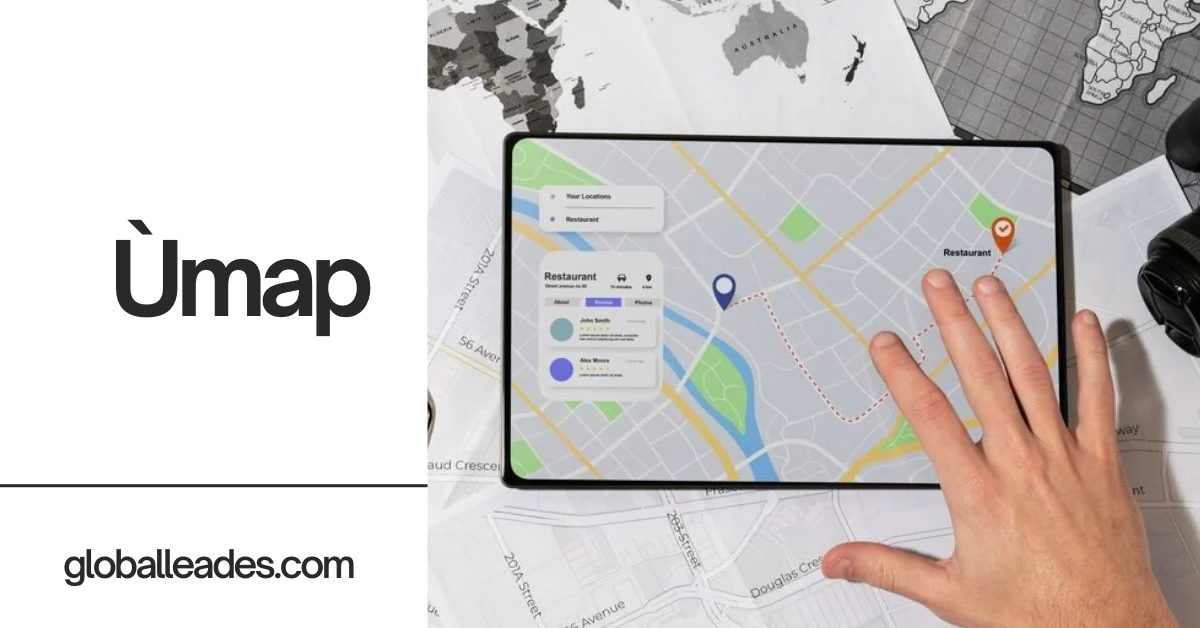In the dynamic world of mapping technologies, Ùmap stands out as a versatile and powerful tool that is reshaping how we perceive and interact with spatial data.
From its humble beginnings to its current status as a cornerstone of modern navigation and data visualization, Ùmap has evolved into an indispensable resource for individuals and businesses alike.
In this comprehensive guide, we’ll delve into the intricacies of Ùmap technology, exploring its origins, key components, functionalities, advantages, challenges, and future trends. By the end of this journey, you’ll have a thorough understanding of Ùmap and how it can revolutionize your approach to mapping and spatial analysis.
What is Ùmap?
Ùmap is a sophisticated platform designed to organize, visualize, and analyze spatial data. It enables users to create interactive maps that incorporate various layers of information, ranging from geographical features to demographic statistics.
Unlike traditional paper maps, Ùmap offers dynamic and customizable interfaces, allowing users to tailor their maps to specific needs and preferences.
Whether you’re a city planner, researcher, or business owner, Ùmap provides the tools you need to make informed decisions and gain valuable insights into spatial relationships and patterns.
Origin and Development of Ùmap Technology
The story of Ùmap is one of continuous innovation and adaptation to emerging technologies. Originally conceived as a basic mapping tool, Ùmap has undergone significant development over the years, expanding its capabilities and functionalities in response to evolving user demands.
Also Read: Yenişaak – Understanding The Technology In 2024
From its early days as a simple geographic mapping tool to its current status as a sophisticated data visualization platform, Ùmap has remained at the forefront of mapping technology, driving progress and innovation in the field.
Key Components of Ùmap Technology
At its core, Ùmap comprises several key components that work together to deliver its impressive capabilities. These include:
- User Interface: Ùmap boasts an intuitive and user-friendly interface that makes it easy for users to create, customize, and interact with maps.
- Data Visualization Tools: Ùmap offers a range of data visualization tools, allowing users to represent spatial data in various formats, such as charts, graphs, and heatmaps.
- Integration Capabilities: Ùmap seamlessly integrates with other software and platforms, enabling users to incorporate data from multiple sources into their maps.
- Customization Options: Ùmap provides extensive customization options, allowing users to personalize their maps with different colors, symbols, and labels.
How Does Ùmap Work?
Ùmap utilizes a combination of geographic information systems (GIS), data visualization techniques, and interactive web technologies to create immersive and engaging maps.
Users can input spatial data into the platform, which is then processed and displayed in a visually appealing and informative manner.
Also Read: RusticoTV – Get Subscription & Membership In 2024
By leveraging advanced mapping algorithms and visualization techniques, Ùmap enables users to explore spatial relationships, identify patterns, and make data-driven decisions with ease.
Types of Ùmap
Ùmap encompasses various types tailored to different applications and objectives. These include:
- Geographical Maps: These maps focus on representing geographic features such as landforms, bodies of water, and political boundaries. They provide a visual representation of the physical landscape, offering insights into spatial relationships and patterns.
- Data Visualization Ùmaps: Designed for presenting statistical data and trends, these maps employ visual elements such as charts, graphs, and heat maps to convey information effectively. They are invaluable tools for analyzing patterns, correlations, and anomalies within datasets.
- Interactive Ùmaps: These maps allow users to interact with spatial data in real-time, enabling dynamic exploration and analysis. Users can zoom in and out, pan across the map, and access additional information through clickable elements, enhancing user engagement and understanding.
Advantages of Using Ùmap
Ùmap offers numerous advantages that set it apart from traditional mapping technologies:
- Enhanced Visualization: Ùmap provides intuitive visualization tools that transform complex spatial data into clear and engaging visuals. Its interactive features allow users to explore data dynamically, gaining insights that may not be apparent from static maps.
- Customization Options: With Ùmap, users have the flexibility to customize maps according to their specific needs and preferences. From adjusting color schemes to adding interactive elements, Ùmap empowers users to create personalized maps tailored to their objectives.
- Accessibility: Ùmap’s user-friendly interface and intuitive design make it accessible to users of all skill levels. Whether you’re a novice or an experienced mapper, Ùmap offers a seamless user experience that fosters creativity and exploration.
- Integration Capabilities: Ùmap seamlessly integrates with other software and platforms, allowing users to leverage external data sources and tools. This interoperability enhances the versatility and utility of Ùmap across different applications and industries.
Ùmap vs. Traditional Mapping Technologies
Compared to traditional mapping technologies, Ùmap offers several distinct advantages. For starters, Ùmap provides greater flexibility and customization options, allowing users to create personalized maps that meet their specific needs.
Additionally, Ùmap offers real-time updates and dynamic elements, ensuring that users always have access to the most up-to-date information.
Also Read: 2045996870 – Technologies Enabling Communication In 2024
Furthermore, Ùmap’s integration capabilities enable users to incorporate data from multiple sources into their maps, providing a comprehensive and holistic view of the spatial landscape.
Challenges and Limitations of Ùmap
Despite its many advantages, Ùmap also faces several challenges and limitations. One of the primary challenges is ensuring the accuracy and reliability of the spatial data used in Ùmap.
Additionally, Ùmap’s advanced features and functionalities can be complex and daunting for new users, requiring time and effort to master.
Furthermore, Ùmap’s integration capabilities can pose technical challenges, especially when dealing with large and diverse datasets. However, with proper training and support, these challenges can be overcome, allowing users to unlock the full potential of Ùmap.
The Applications of Ùmap
The applications of Ùmap are diverse and far-reaching, spanning a wide range of industries and sectors. Some common applications include:
Urban Planning and Development:
Ùmap facilitates urban planning and development by providing insights into population demographics, infrastructure networks, and land use patterns. Planners can use Ùmap to visualize proposed projects, assess their impact on the community, and optimize resource allocation for sustainable growth.
Environmental Conservation:
In the field of environmental conservation, Ùmap plays a crucial role in monitoring ecosystems, identifying conservation priorities, and mitigating environmental risks. Conservationists can use Ùmap to track deforestation, monitor wildlife habitats, and prioritize conservation efforts based on ecological data.
Emergency Response and Disaster Management:
Ùmap aids emergency response and disaster management efforts by providing real-time situational awareness, coordinating rescue operations, and assessing damage assessments. Emergency responders can use Ùmap to visualize affected areas, identify evacuation routes, and allocate resources effectively during crises.
Also Read: 2045996870 – Technologies Enabling Communication In 2024
Business Intelligence and Market Analysis:
In the business world, Ùmap serves as a valuable tool for market analysis, competitor mapping, and customer segmentation. Businesses can use Ùmap to identify target demographics, analyze consumer behavior, and optimize marketing strategies based on spatial insights.
Case Studies: Successful Implementations of Ùmap
Numerous organizations have successfully implemented Ùmap to address specific challenges and achieve their objectives:
- City of Los Angeles: The City of Los Angeles uses Ùmap to enhance public engagement, improve service delivery, and promote transparency in governance. Through interactive maps, residents can access information about city services, infrastructure projects, and neighborhood demographics, empowering them to make informed decisions and participate in civic affairs.
- National Park Service: The National Park Service utilizes Ùmap to manage and protect natural resources within its vast network of parks and recreational areas. Park rangers can use Ùmap to monitor wildlife populations, track visitor use patterns, and implement conservation strategies to preserve ecological integrity.
- Retail Chain: A retail chain leverages Ùmap to optimize store locations, analyze market demand, and expand its customer base. By overlaying demographic data, competitor locations, and consumer preferences on interactive maps, the retailer can identify strategic opportunities for growth and tailor its product offerings to local market conditions.
How Businesses Can Leverage Ùmap
Businesses can leverage Ùmap to gain a competitive edge and drive growth in various ways:
Location Intelligence: Ùmap provides businesses with valuable location intelligence that informs strategic decision-making, such as site selection, expansion planning, and market penetration. By analyzing spatial data trends and consumer behavior patterns, businesses can identify prime locations, target lucrative markets, and optimize their geographic footprint.
Supply Chain Optimization: Ùmap aids businesses in optimizing their supply chain operations by visualizing distribution networks, identifying bottlenecks, and streamlining logistics processes. By mapping transportation routes, warehouse locations, and inventory levels, businesses can enhance efficiency, reduce costs, and improve customer satisfaction.
Also Read: кинокрад – Смотреть фильмы онлайн бесплатно
Customer Engagement: Ùmap enhances customer engagement by providing interactive maps that facilitate personalized experiences, location-based promotions, and targeted marketing campaigns. Businesses can use Ùmap to create custom maps highlighting store locations, product availability, and special offers, driving foot traffic and increasing sales.
Best Practices for Utilizing Ùmap
To maximize the value of Ùmap, organizations should adhere to best practices:
- Define Objectives: Clearly define the objectives and use cases for using Ùmap within your organization. Whether it’s improving operational efficiency, enhancing customer engagement, or supporting decision-making, align Ùmap usage with strategic goals and priorities.
- Invest in Training: Provide comprehensive training and support resources to users to build proficiency in Ùmap usage. Offer tutorials, workshops, and ongoing education opportunities to empower users with the knowledge and skills needed to leverage Ùmap effectively.
- Data Quality Assurance: Prioritize data quality assurance to ensure the accuracy, reliability, and integrity of the data used in Ùmap. Conduct regular audits, validate data sources, and implement quality control measures to minimize errors and discrepancies in spatial data.
Future Trends in Ùmap Technology
The future of Ùmap technology is marked by several emerging trends and innovations:
Artificial Intelligence and Machine Learning: Ùmap will increasingly incorporate artificial intelligence (AI) and machine learning (ML) algorithms to automate data analysis, predict trends, and optimize decision-making processes. AI-powered Ùmap solutions will offer advanced capabilities such as predictive analytics, anomaly detection, and spatial modeling, enabling users to derive actionable insights from complex datasets.
Also Read: Käämtäjä – Know The Importance In 2024
Real-Time Data Integration: Ùmap will evolve to support real-time data integration from diverse sources, including IoT devices, social media feeds, and satellite imagery. This real-time data integration will enable users to access up-to-date information, monitor changes in real-time, and respond promptly to emerging events and trends.
Augmented Reality and Virtual Reality: Ùmap will leverage augmented reality (AR) and virtual reality (VR) technologies to provide immersive mapping experiences that blend digital information with real-world environments. AR-enabled Ùmap applications will overlay spatial data onto the user’s physical surroundings, while VR-enabled Ùmap platforms will offer immersive 3D visualization capabilities, enhancing spatial understanding and decision-making.
Conclusion
Ùmap stands at the forefront of mapping technology, offering a powerful platform for organizing, visualizing, and analyzing spatial data.
From urban planning and environmental conservation to business intelligence and market analysis, Ùmap empowers organizations to derive actionable insights, make informed decisions, and drive innovation.
As Ùmap continues to evolve and embrace emerging technologies, its role in shaping the future of mapping technology will only grow, unlocking new possibilities and opportunities for users across various industries.
FAQs
Can Ùmap be used for indoor navigation?
No, Ùmap is primarily designed for outdoor mapping and does not support indoor navigation functionalities.
Does Ùmap provide real-time weather updates?
No, Ùmap does not offer real-time weather updates. It focuses on mapping and spatial analysis rather than providing weather information.
Can I use Ùmap to create virtual reality experiences?
No, Ùmap does not currently support the creation of virtual reality experiences. It is primarily used for mapping, data visualization, and geographical analysis.
Is Ùmap compatible with all operating systems?
No, Ùmap may not be compatible with all operating systems. It’s essential to check the system requirements before using Ùmap to ensure compatibility.
Can I print maps created with Ùmap?
Yes, you can print maps created with Ùmap. It supports printing functionality, allowing you to generate hard copies of your maps for various purposes.
Does Ùmap offer satellite imagery?
No, Ùmap does not provide satellite imagery. It primarily relies on other mapping data sources for its visualizations and analyses.
Can I collaborate with others in real-time using Ùmap?
No, Ùmap does not currently offer real-time collaboration features. However, you can share your maps with others and collaborate asynchronously by exchanging feedback and suggestions.




